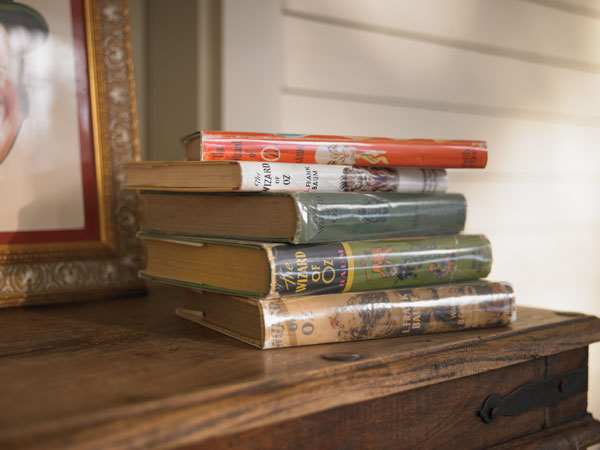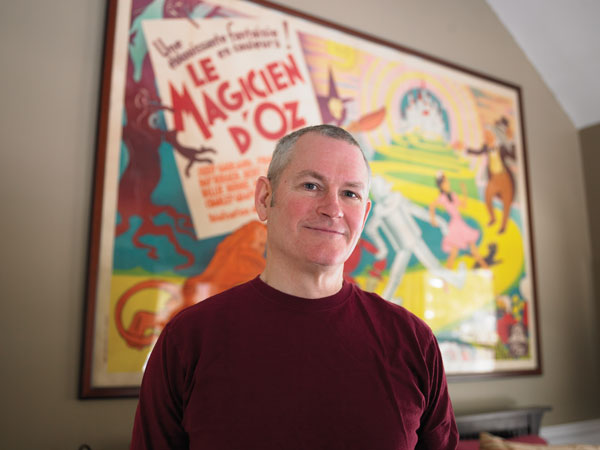Oz Comes to Peyton Place
FEATURE-May 2011
By Kathrin Seitz | Photography Scott Dorrance
Two iconic collections find a home in Camden
It’s a Friday evening in May, and my husband, Richard, and I are gathered with Tom Wilhite and Willard Carroll in their kitchen, on the outskirts of Camden, drinking wine and watching Willard prepare dinner. Tom and Willard cofounded the film-production company Hyperion Pictures in 1984, and they recently relocated to Maine. Although it’s our first visit to their new house, I’ve known Tom and Willard since our Hollywood days together, and Rich and I want to hear the story of what brought them to Camden. While Willard prepares dinner, he moves adroitly around the kitchen and sneaks the occasional peak at one of his favorite old movies, Bigger Than Life, which is playing on the monitor next to the stove. As I talk with Tom, my eye follows Willard. Above his head, I spot an original movie poster for the 1941 animated film Hoppity Goes to Town. And when we move into the living room, my husband points out an exquisite piece of art above the fireplace, a poster for a 1903 New York stage production of The Wizard of Oz. In the master bedroom, we discover a poster for the 1940 release of the French version of MGM’s Judy Garland classic, The Wizard of Oz. In the bathroom is another original film poster, this one for the 1957 theatrical release of Peyton Place.
Rich and I both have the same question: “What’s up with all this?” Tom answers, “We collect Oz memorabilia.” Then he quietly adds, “It’s the foremost Oz collection in the world.” I’ve known Tom and Willard for years, but I had no idea. We learn that the collection consists of more than 50,000 pieces, all of which were hauled from Los Angeles to Camden in two semitrucks last year. The collection includes rare and one-of-a-kind pieces such as the actual Wicked Witch’s hourglass that Dorothy watches in the film as her life fades away; the dress that Judy Garland wore in the movie; a Lollipop Guild Munchkin costume (the movie’s most complete existing costume, including socks and underwear); and stacks of first editions, original illustrations and posters, and merchandise. The full inventory of memorabilia, books, film props, and artwork is 300 single-spaced pages long.
Tom continues to tell us about the collection. “Except for the loan of several items to the Library of Congress and a major exhibition of our collection in Los Angeles in 2000, on the 100th anniversary of the publication of L. Frank Baum’s book, The Wonderful Wizard of Oz,” he says, “our collection has never been publicly exhibited.” For the moment, the collection is securely stored in Camden, most of it still in boxes. We learn later in the evening about their plans for the collection here in Maine, and the story of how it came to be in the first place.
Willard began collecting when he was four years old. Proctor and Gamble sponsored the Wizard of Oz movie once a year and offered free Oz puppets with their Ivory Soap products. Eventually, Willard’s mother had a closetful of Ivory and Willard had a bunch of puppets—which he still owns. In 1967, when he was thirteen years old, ABC aired Off to See the Wizard, a family-oriented television series. “There were tons of collectibles associated with that series and I bought as many as possible,” Willard says.
That same year he began collecting the Oz books, and he managed to cobble together enough money from his after-school job to buy a first edition. Willard and Tom now own 15,000 books, including a complete set of every L. Frank Baum first edition and the world’s preeminent collection of foreign Oz books and posters. Willard has traveled his entire adult life, and wherever he goes he buys foreign editions of The Wonderful Wizard of Oz.
“I stopped collecting when I went to college because I thought it might be time to grow up,” Willard says. “But when I started working professionally, I realized I wasn’t particularly interested in stocks and bonds, so I invested in the things I loved. I began to recognize at that point that collecting isn’t a choice—either you’re born a collector or not.” After attending film school at the University of Southern California, Willard pursued a career as a writer, director, and producer in the television and film industries. And he also continued collecting.
Tom and Willard met twenty-five years ago when they both worked for Disney. Eventually, they got together and started Hyperion. “While I don’t have Willard’s collector’s chromosome,” Tom says, “I understand the importance of Oz to him for nostalgic, historic, and aesthetic reasons. And I certainly get the significance of Oz to our popular culture—it’s America’s first indigenous fairy tale.”
So, how does Peyton Place fit into this story?
“Peyton Place was my favorite television show when I was a child,” says Willard, who grew up in a small town and saw a lot of truth in the fictional portrayal of Peyton Place. Thus began their second collection, which is undoubtedly the most substantial Peyton Place collection in existence.
As it turns out, Peyton Place is what brought Tom and Willard to Camden, since the film was shot here in 1957. In 2007, the fiftieth anniversary of the movie’s release, Willard was bidding against Greg Marquise, who then owned the Whitehall Inn (a central location in the movie), for a piece of Peyton Place ephemera. The two men became friendly, Greg asked to borrow several pieces from their collection for an anniversary celebration, and he invited Tom and Willard to attend. “It was summer, and it was the first time we had been to Maine,” Willard recalls. “After five minutes, we said, ‘This is it!’ We had both grown up in small towns and were ready to return to one after thirty-five years in L.A.”
Tom and Willard now plan to make their Oz collection the foundation for the National Oz Museum for students, kids, and families, which will be housed in a separate 5,000-square-foot building on their
eighty-acre property. In fact, re-imagining that building as a museum will be the subject of an interior architecture department project this fall at Rhode Island School of Design. “What excites us about bringing our Oz collection to Camden is the idea of turning its substance into a center of gravity for a larger gathering place focused on literature and illustration for young people,” Tom says. “A big part of our business over the years has been kids and family movies and television, so we feel an obligation to give something back to this audience.”
As part of their Oz project, they are collaborating with Bay Chamber Concerts to develop and stage an original children’s opera based on The Road to Oz, the fifth Oz book written by L. Frank Baum. The opera will premiere at Camden Opera House in late 2012 before it travels to other venues in Maine and beyond.
In addition to their Oz initiative, Tom and Willard’s Hyperion Pictures has several projects in development, most of which they intend to produce in Maine. Tom says that their focus now is finding projects “that can logically be made in or managed from here.” Willard wrote and will direct one of those projects, the psychological thriller Crawl, which will be shot in Bangor.
“Maine has immense creative energy and talent,” Tom says. “And today you can make a movie from just about anywhere in the world; it’s increasingly about email, mobile, and file sharing.”
Oz, that Technicolor land of fantasy, family, and self-discovery, has come to Peyton Place. Just follow the Yellow Brick Road.
National Oz Museum:
nationalozmuseum.com












